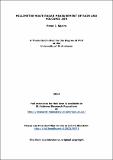Files in this item
Millimetre-wave radar measurement of rain and volcanic ash
Item metadata
| dc.contributor.advisor | Smith, Graham Murray | |
| dc.contributor.author | Speirs, Peter James | |
| dc.coverage.spatial | xii, 302 p. | en_US |
| dc.date.accessioned | 2015-07-13T09:13:53Z | |
| dc.date.available | 2015-07-13T09:13:53Z | |
| dc.date.issued | 2014 | |
| dc.identifier | uk.bl.ethos.658897 | |
| dc.identifier.uri | https://hdl.handle.net/10023/6971 | |
| dc.description.abstract | This thesis presents the development of various methods for measuring rainfall rates using horizontally-pointing millimetre-wave radars. This work builds from the combination of a T-matrix scattering model that allows the scattering from almost arbitrarily pro led rotationally symmetric particles to be calculated, and drop shape models that allow the effects of temperature and pressure on the shape to be taken into account. Many hours of rain data have been collected with 38 and 94 GHz FMCW radars, as well as with a disdrometer and weather station. These have been used to develop single- and dual-frequency techniques for measuring rainfall rate. A temperature, polarisation and attenuation corrected application of simple power-law relationships between reflectivity and rainfall rate has been successfully demonstrated at 38 GHz. However, at 94 GHz it has been found that more detailed functions relating reflectivity, attenuation and rainfall rate are beneficial. A reflectivity-based determination of attenuation has been adapted from the literature and successfully applied to the 94 GHz data, improving the estimate of rainfall rate at longer ranges. The same method for estimating attenuation has also been used in a dualfrequency technique based on the ratio of the extinction coefficients at 38 and 94 GHz, but with less success. However, a dual-frequency reflectivity ratio based approach has been successfully developed and applied, producing good estimates of rainfall rate, as well as reasonable estimates of two drop-size distribution parameters. Simulations of radar measurements of airborne volcanic ash have also been carried out, demonstrating that for most reasonable measurement configurations the optimal frequencies would typically be 35 GHz or 94 GHz, not the more commonly used 3-10 GHz. It has also been shown that various existing millimetre-wave radars could be used to detect ash. Finally, there is a discussion of the optimal frequencies for dual-frequency measurement of volcanic ash. | en_US |
| dc.language.iso | en | en_US |
| dc.publisher | University of St Andrews | |
| dc.subject.lcc | QC973.5S7 | |
| dc.subject.lcsh | Radar meteorology | en_US |
| dc.subject.lcsh | Millimeter wave devices | en_US |
| dc.subject.lcsh | Rain and rainfall--Measurement | en_US |
| dc.subject.lcsh | Volcanic ash, tuff, etc.--Measurement | en_US |
| dc.title | Millimetre-wave radar measurement of rain and volcanic ash | en_US |
| dc.type | Thesis | en_US |
| dc.contributor.sponsor | Engineering and Physical Sciences Research Council (EPSRC) | en_US |
| dc.type.qualificationlevel | Doctoral | en_US |
| dc.type.qualificationname | PhD Doctor of Philosophy | en_US |
| dc.publisher.institution | The University of St Andrews | en_US |
This item appears in the following Collection(s)
Items in the St Andrews Research Repository are protected by copyright, with all rights reserved, unless otherwise indicated.

